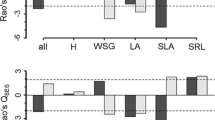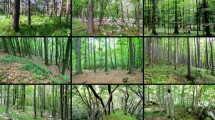Abstract
Community ecologists seek to understand the processes acting on community assembly and the importance of species ecological differences to the co-existence of organisms. Here we investigated trait distribution patterns in two contrasting vegetation types, how the inclusion of intraspecific variability improves our ability to understand trait-based assembly, and if soil features predict the occurrence of non-random trait distribution patterns. We conducted our study at Emas National Park, Goiás, Brazil. We used a null model approach to investigate trait distribution patterns and a model selection approach to quantify soil features important in structuring assemblages. In savanna, we detected trait convergence at individual and species level (evidence of environmental filters) favoring plants with resource conservation strategies. In forests, however, trait dispersion at individual level equal to a random expectation corroborated a premise of neutral theory (individuals ecological equivalence). Nevertheless, at species level, we found convergence (seed mass) and divergence (height), reflecting distinct strategies related to light capture and resource use. Therefore, including intraspecific trait variability did not improve the detection of non-random trait distribution patterns. Furthermore, the influence of soil features on trait patterns was different between savanna and forest. There was a tendency for niche differentiation toward more fertile and clayey soils, but the relative importance of soil factors in assembling communities could not be generalized for savannas and dry forests.

Similar content being viewed by others
References
Aiba M, Katabuchi M, Takafumi H et al (2013) Robustness of trait distribution metrics for community assembly studies under the uncertainties of assembly processes. Ecology 94:2873–2885
Albert CH, Thuiller W, Yoccoz NG et al (2010) Intraspecific functional variability: extent, structure and sources of variation. J Ecol 98:604–613. doi:10.1111/j.1365-2745.2010.01651.x
Angiosperm Phylogeny Group (2009) An update of the angiosperm phylogeny group classification for the orders and families of flowering plants: APG III. Bot J Linn Soc 161:105–121
Batalha MA, Silva IA, Cianciaruso MV, Carvalho GH (2011) Trait diversity on the phylogeny of cerrado woody species. Oikos 120:1741–1751. doi:10.1111/j.1600-0706.2011.19513.x
Burnham KP, Anderson DR (2002) Model selection and multimodel inference: a practical information—theoretic approach, 2nd edn. Springer, Berlin
Burnham KP, Anderson DR, Huyvaert KP (2011) AIC model selection and multimodel inference in behavioral ecology: some background, observations, and comparisons. Behav Ecol Sociobiol 65:23–35. doi:10.1007/s00265-010-1029-6
Carvalho GH, Cianciaruso MV, Batalha MA (2010) Plantminer: a web tool for checking and gathering plant species taxonomic information. Environ Model Softw 25:815–816. doi:10.1016/j.envsoft.2009.11.014
Chalmandrier L, Münkemüller T, Gallien L et al (2013) A family of null models to distinguish between environmental filtering and biotic interactions in functional diversity patterns. J Veg Sci 24:853–864. doi:10.1111/jvs.12031
Christianini AV (2007) Interações entre formigas, frutos e sementes em solo de cerrado: o papel de formigas na biologia de sementes e plântulas, p 187
Cianciaruso MV, Silva IA, Batalha MA et al (2012) The influence of fire on phylogenetic and functional structure of woody savannas: moving from species to individuals. Perspect Plant Ecol Evol Syst. doi:10.1016/j.ppees.2011.11.004
Cornelissen JHC, Lavorel S, Garnier E et al (2003) A handbook of protocols for standardised and easy measurement of plant functional traits worldwide. Aust J Bot 51:335–380
Cornwell WK, Ackerly DD (2009) Community assembly and shifts in plant trait distributions across an environmental gradient in coastal California. Ecol Monogr 79:109–126
Crawley MJ (1997) Life history and environment, 2nd edn., Plant ecologyBlackwell Science, Oxford, pp 73–132
Dantas VL, Batalha MA, Pausas JG (2013a) Fire drives functional thresholds on the savanna—forest transition. Ecology 94:2454–2463
Dantas VL, Pausas JG, Batalha MA et al (2013b) The role of fire in structuring trait variability in neotropical savannas. Oecologia 171:487–494. doi:10.1007/s00442-012-2431-8
Díaz S, Cabido M, Casanoves F (1998) Plant functional traits and environmental filters at a regional scale. J Veg Sci 9:113–122
Diniz-filho JAF, Bini LM, Hawkins BA (2003) Spatial autocorrelation and red herrings in geographical ecology. Glob Ecol Biogeogr 12:53–64
de Souza TV, Voltolini CH, Santos M, Silveira Paulilo MT (2012) Water absorption and dormancy-breaking requirements of physically dormant seeds of Schizolobium parahyba (Fabaceae–Caesalpinioideae). Seed Sci Res 22:169–176. doi:10.1017/S0960258512000013
Durigan G, Baitello JB, Franco GADC, Siqueira MF (2004) Plantas do Cerrado paulista: imagens de uma paisagem ameaçada, p 475
Embrapa (1997) Manual de métodos de análise de solo. Embrapa, Rio de Janeiro
Embrapa (1998) Análises químicas para avaliação da fertilidade do solo: métodos usados na Embrapa Solos. Embrapa, Rio de Janeiro
Grime JP (2006) Trait convergence and trait divergence in herbaceous plant communities: mechanisms and consequences. J Veg Sci 17:255–260. doi:10.1111/j.1654-1103.2006.tb02444.x
Harper JL, Lovell PH, Moore KG (1970) The shapes and sizes of seeds. Annu Rev Ecol Syst 1:327–356
Hoffmann WA, Geiger EL, Gotsch SG et al (2012) Ecological thresholds at the savanna-forest boundary: how plant traits, resources and fire govern the distribution of tropical biomes. Ecol Lett 15:759–768. doi:10.1111/j.1461-0248.2012.01789.x
Hubbell SP (2001) The unified neutral theory of biodiversity and biogeography. Princeton University Press, Princeton
Jardim AVF, Batalha MA (2008) Can we predict dispersal guilds based on the leaf-height-seed scheme in a disjunct cerrado woodland? Braz J Biol 68:553–559
Jung V, Violle C, Mondy C et al (2010) Intraspecific variability and trait-based community assembly. J Ecol 98:1134–1140. doi:10.1111/j.1365-2745.2010.01687.x
Kraft NJB, Ackerly DD (2010) Functional trait and phylogenetic tests of community assembly across spatial scales in an Amazonian forest. Ecol Monogr 80:401–422
Kraft NJB, Valencia R, Ackerly DD (2008) Functional traits and niche-based tree community assembly in an amazonian forest. Science 322(80):580–582
Laliberté E, Norton DA, Scott D (2013) Contrasting effects of productivity and disturbance on plant functional diversity at local and metacommunity scales. J Veg Sci 24:834–842. doi:10.1111/jvs.12044
Laughlin DC, Leppert JJ, Moore MM, Sieg CH (2010) A multi-trait test of the leaf-height-seed plant strategy scheme with 133 species from a pine forest flora. Funct Ecol 24:493–501. doi:10.1111/j.1365-2435.2009.01672.x
Lavergne S, Garnier E, Debussche M (2003) Do rock endemic and widespread plant species differ under the leaf-height-seed plant ecology strategy scheme ? Ecol Lett 6:398–404
Lehsten V, Kleyer M (2007) Turnover of plant trait hierarchies in simulated community assembly in response to fertility and disturbance. Ecol Model 203:270–278. doi:10.1016/j.ecolmodel.2006.11.034
Leishman MR (2001) Does the seed size/number trade-off model determine plant community structure ? An assessment of the model mechanisms and their generality. Oikos 93:294–302
Leishman MR, Wright IJ, Moles AT, Westoby M (2000) The evolutionary ecology of seed size. Seeds Ecol Regen Plant Communities. 2:31–57
Liancourt P, Tielbörger K, Bangerter S, Prasse R (2009) Components of “competitive ability” in the LHS model: implication on coexistence for twelve co-occurring Mediterranean grasses. Basic Appl Ecol 10:707–714. doi:10.1016/j.baae.2009.05.003
Lorenzi H (1998) Árvores brasileiras: manual de identificação e cultivo de plantas arbóreas nativas do Brasil, vol 2, 2nd edn. Instituto Plantarum de Estudos da Flora, Nova Odessa, p 352
Lorenzi H (2000) Árvores brasileiras: manual de identificação e cultivo de plantas arbóreas nativas do Brasil, vol 1, 3rd edn., p 352
Lorenzi H (2009) Árvores brasileiras: manual de identificação e cultivo de plantas arbóreas nativas do Brasil, vol 3, p 384
Mayfield MM, Levine JM (2010) Opposing effects of competitive exclusion on the phylogenetic structure of communities. Ecol Lett 13:1085–1093. doi:10.1111/j.1461-0248.2010.01509.x
Michaels HJ, Benner B, Hartgerink AP et al (1988) Seed size variation: magnitude, distribution, and ecological correlates. Evol Ecol 2:157–166
Møller AP, Jennions MD (2002) How much variance can be explained by ecologists and evolutionary biologists? Oecologia 132:492–500
Moog D, Kahmen S, Poschlod P (2005) Application of CSR- and LHS-strategies for the distinction of differently managed grasslands. Basic Appl Ecol 6:133–143. doi:10.1016/j.baae.2005.01.005
Muller-Landau HC (2010) The tolerance-fecundity trade-off and the maintenance of diversity in seed size. Proc Natl Acad Sci USA 107:4242–4247. doi:10.1073/pnas.0911637107
Neves F, Araújo LS, Espírito-Santo MM et al (2010) Canopy herbivory and insect herbivore diversity in a dry forest: savanna transition in Brazil. Biotropica 42:112–118
Obeso JR, Herrera CM (1994) Inter- and intraspecific variation in fruit traits in co-occurring vertebrate-dispersed plants. Int J Plant Sci 155:382–387
Ordoñez JC, van Bodegom PM, Witte J-PM et al (2009) A global study of relationships between leaf traits, climate and soil measures of nutrient fertility. Glob Ecol Biogeogr 18:137–149. doi:10.1111/j.1466-8238.2008.00441.x
Paine CET, Baraloto C, Chave J, Hérault B (2011) Functional traits of individual trees reveal ecological constraints on community assembly in tropical rain forests. Oikos 120:720–727. doi:10.1111/j.1600-0706.2010.19110.x
Pakeman RJ, Lepš J, Kleyer M et al (2009) Relative climatic, edaphic and management controls of plant functional trait signatures. J Veg Sci 20:148–159
Pausas JG, Verdú M (2008) Fire reduces morphospace occupation in plant communities. Ecology 89:2181–2186. doi:10.1890/07-1737.1
Paz H, Martínez-Ramos M (2003) Seed mass and seedling performance within eight species of Psychotria (Rubiaceae). Ecology 84:439–450
Peres-Neto PR, Jackson DA, Somers KM (2003) Giving meaningful interpretation to ordination axes: assenssing loading significance in principal component analysis. Ecology 84:2347–2363
Quinn GP, Keough MJ (2002) Experimental design and data analysis for biologists. Cambridge University Press, Cambridge, p 534
Ramos VS, Durigan G, Franco GADC, Siqueira MF (2008) Árvores da floresta estacional semidecidual: guia de identificação de espécies, p 320
Rangel TF, Diniz-Filho JAF, Bini LM (2010) SAM: a comprehensive application for spatial analysis in macroecology. Ecography (Cop) 33:46–50. doi:10.1111/j.1600-0587.2009.06299.x
R Development Core Team (2010) R: a language and environment for statistical computing
Rede de Sementes do Cerrado (2010) REDE DE SEMENTES DO CERRADO. http://www.sementesdocerrado.bio.br
Rede de Sementes do Xingu (2010) REDE DE SEMENTES DO XINGU. http://www.sementesdoxingu.org.br/web/index.php
Reich PB, Walters MB, Ellsworth DS (1992) Leaf life-span in relation to leaf, plant, and stand characteristics among diverse ecosystems. Ecol Monogr 62:365–392
Reich PB, Ellsworth DS, Walters MB et al (1999) Generality of leaf trait relationships: a test across six biomes. Ecology 80:1955–1969
Royal Botanic Gardens Kew (2008) Seed information database (SID). http://data.kew.org/sid/
Ruggiero PGC, Batalha MA, Pivello VR, Meirelles ST (2002) Soil-vegetation relationships in cerrado (Brazilian savanna) and semideciduous forest, Southeastern Brazil. Plant Ecol 160:1–16
Schamp BS, Aarssen LW (2009) The assembly of forest communities according to maximum species height along resource and disturbance gradients. Oikos 118:564–572. doi:10.1111/j.1600-0706.2009.16589.x
Siefert A (2012) Incorporating intraspecific variation in tests of trait-based community assembly. Oecologia 170:767–775. doi:10.1007/s00442-012-2351-7
Silva DM, Batalha MA (2011) Defense syndromes against herbivory in a cerrado plant community. Plant Ecol 212:181–193. doi:10.1007/s11258-010-9813-y
Silva Júnior MC (2005) 100 árvores do Cerrado: guia de campo, p 278
Silvertown J (2004) Plant coexistence and the niche. Trends Ecol Evol 19:605–611
Stubbs WJ, Wilson JB (2004) Evidence for limiting similarity in a sand dune community. J Ecol 92:557–567. doi:10.1111/j.0022-0477.2004.00898.x
Violle C, Castro H, Richarte J, Navas M-L (2009) Intraspecific seed trait variations and competition: passive or adaptive response? Funct Ecol 23:612–620. doi:10.1111/j.1365-2435.2009.01539.x
Violle C, Enquist BJ, McGill BJ et al (2012) The return of the variance: intraspecific variability in community ecology. Trends Ecol Evol 27:244–252
Weiher E, Keddy PA (1995) Assembly rules, null models and trait dispersion: new questions from old patterns. Oikos 74:159–164
Westoby M (1998) A leaf-height-seed (LHS) plant ecology strategy scheme. Plant Soil 199:213–227
Westoby M, Falster DS, Moles AT et al (2002) Plant ecological strategies: some leading dimensions of variation between species. Annu Rev Ecol Syst 33:125–159. doi:10.1146/annurev.ecolsys.33.010802.150452
Acknowledgments
We are grateful to Conselho Nacional de Desenvolvimento Científico e Tecnológico (#478747/2009-8), Fundação de Amparo à Pesquisa do Estado de Goiás, and Programa Ecológico de Longa Duração—site 13 for financial support; to Coordenação de Aperfeiçoamento de Pessoal de Nível Superior for the scholarship granted to the first author; to Leandro Maracahipes, Edmar A. Oliveira, Paulo Zava, Rhayane Werneck and Giovana Zilli for helping us in the field. Mário Almeida Neto, Sandra Müller, two anonymous reviewers, and Philip Ladd provided important comments on the manuscript. Marcus Cianciaruso has a productivity grant from Conselho Nacional de Desenvolvimento Científico e Tecnológico (306843/2012-9).
Author information
Authors and Affiliations
Corresponding author
Additional information
Communicated by Philip Ladd.
Electronic supplementary material
Below is the link to the electronic supplementary material.
Rights and permissions
About this article
Cite this article
Laureto, L.M.O., Cianciaruso, M.V. Trait distribution patterns in savanna and forest plant assemblages and their relationship with soil features. Plant Ecol 216, 629–639 (2015). https://doi.org/10.1007/s11258-015-0464-x
Received:
Accepted:
Published:
Issue Date:
DOI: https://doi.org/10.1007/s11258-015-0464-x




